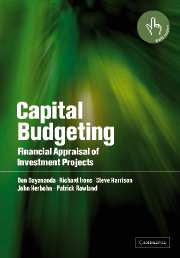Book contents
- Frontmatter
- Contents
- List of figures
- List of tables
- Preface
- 1 Capital budgeting: an overview
- 2 Project cash flows
- 3 Forecasting cash flows: quantitative techniques and routes
- 4 Forecasting cash flows: qualitative or judgemental techniques
- 5 Essential formulae in project appraisal
- 6 Project analysis under certainty
- 7 Project analysis under risk
- 8 Sensitivity and break-even analysis
- 9 Simulation concepts and methods
- 10 Case study in financial modelling and simulation of a forestry investment
- 11 Resource constraints and linear programming
- 12 More advanced linear programming concepts and methods
- 13 Financial modelling case study in forestry project evaluation
- 14 Property investment analysis
- 15 Forecasting and analysing risks in property investments
- 16 Multinational corporations and international project appraisal
- References
- Index
Preface
Published online by Cambridge University Press: 14 May 2010
- Frontmatter
- Contents
- List of figures
- List of tables
- Preface
- 1 Capital budgeting: an overview
- 2 Project cash flows
- 3 Forecasting cash flows: quantitative techniques and routes
- 4 Forecasting cash flows: qualitative or judgemental techniques
- 5 Essential formulae in project appraisal
- 6 Project analysis under certainty
- 7 Project analysis under risk
- 8 Sensitivity and break-even analysis
- 9 Simulation concepts and methods
- 10 Case study in financial modelling and simulation of a forestry investment
- 11 Resource constraints and linear programming
- 12 More advanced linear programming concepts and methods
- 13 Financial modelling case study in forestry project evaluation
- 14 Property investment analysis
- 15 Forecasting and analysing risks in property investments
- 16 Multinational corporations and international project appraisal
- References
- Index
Summary
Capital budgeting is primarily concerned with how a firm makes decisions on sizable investments in long-lived projects to achieve the firm's overall goal. This is the decision area of financial management that establishes criteria for investing resources in long-term real assets.
Investment decisions (on sizable long-term projects) today will determine the firm's strategic position many years hence, and fix the future course of the firm. These investments will have a considerable impact on the firm's future cash flows and the risk associated with those cash flows. Capital budgeting decisions have a long-range impact on the firm's performance and they are critical to the firm's success or failure.
One of the most crucial and complex stages in the capital budgeting decision process is the financial or economic evaluation of the investment proposals. This ‘project analysis’ is the focus of this book. Project analysis usually involves the identification of relevant cash flows, their forecasting, risk analysis, and the application of project evaluation concepts, techniques and criteria to assess whether the proposed projects are likely to add value to the firm. When the project choice is subject to resource constraints, mathematical programming techniques such as linear programming are employed to select the feasible optimal combination of projects.
- Type
- Chapter
- Information
- Capital BudgetingFinancial Appraisal of Investment Projects, pp. xvii - xxPublisher: Cambridge University PressPrint publication year: 2002



